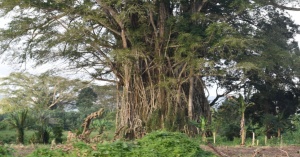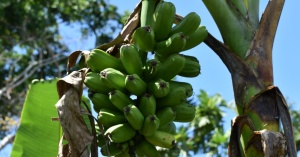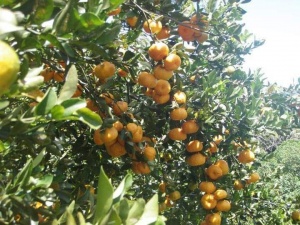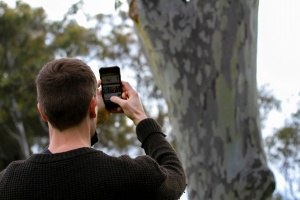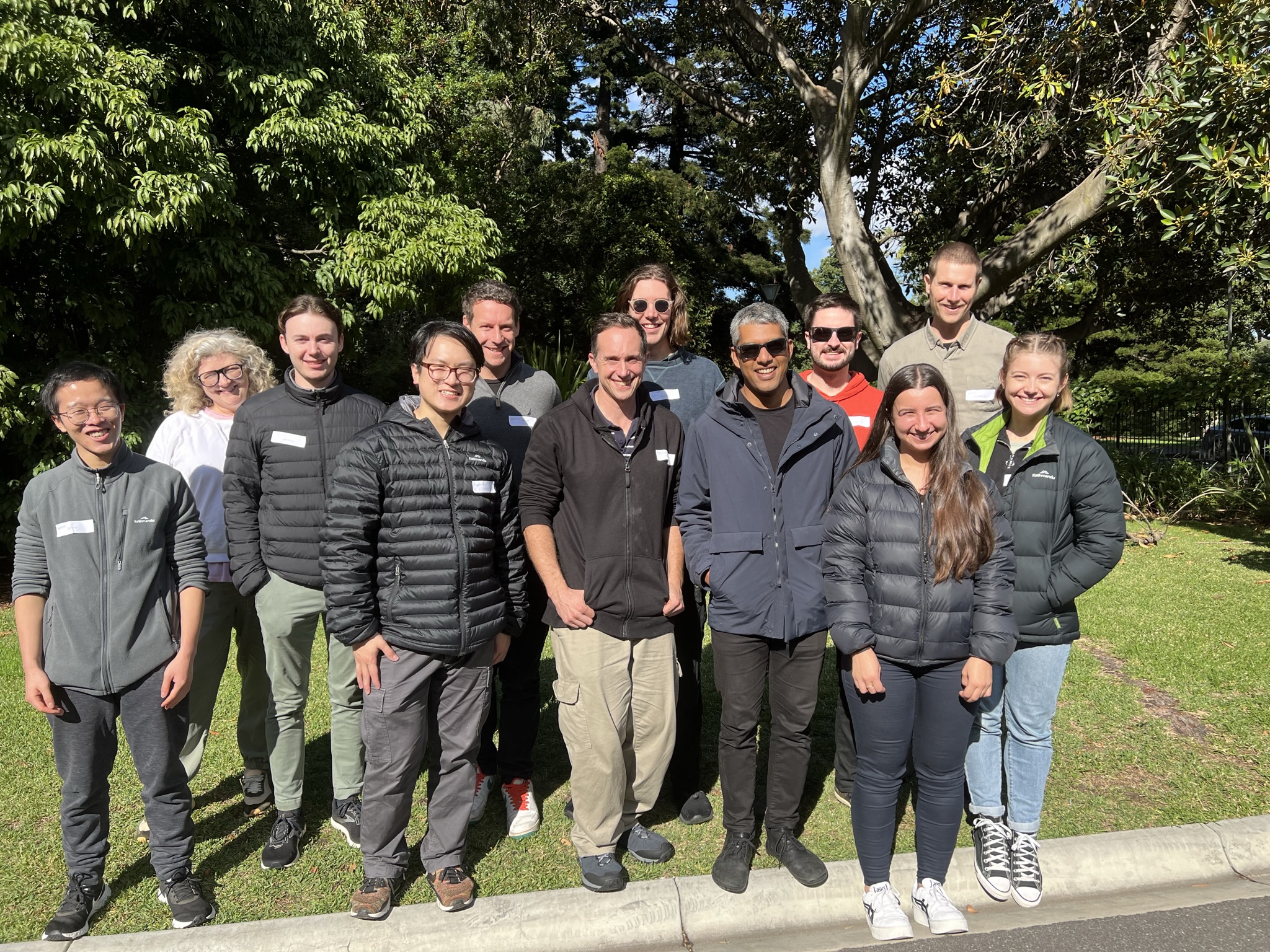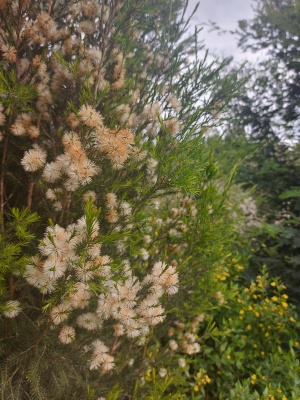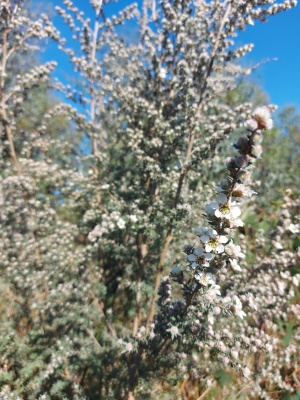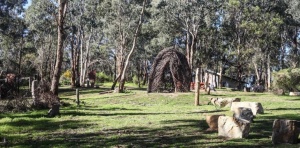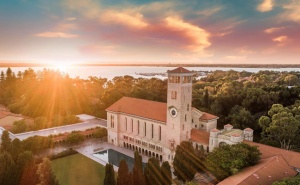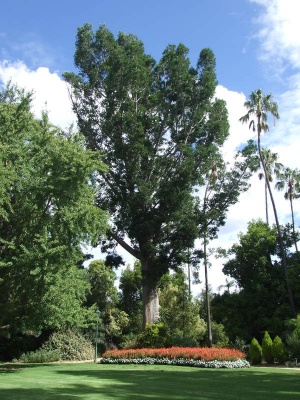Jen Sutfin
Nabanga (Banyan)
Ficus obliqua
Nabanga are also known as Banyan Tree and Small-leaved Fig is native to eastern Australia, New Guinea, eastern Indoneasia to Sulawesi and islands in the south-western Pacific Ocean.
It starts its life growing either on other species or on rocks. Nabanga that grow on other plants, will eventually grow to encase, or strangle, the host tree. The aerial roots form stout pillars that resemble tree trunks and allow the tree to continue to expand as it ages. It can grow 15 – 60 m high with a similar width. The bark is smooth, thin, and grey and the trunk is buttressed and up to 3 m in diameter.
Leaves
Glossy green, elliptic to oblong. 5-8 cm long and 2 – 3.5 cm wide. Channelled on the upper surface.
Flowers
Tiny flowers arise from the inner surface of the fruit, known as an inverted inflorescence. Within any given fruit, the male flowers will mature several weeks after the female flowers.
Fruit
The fruit are round with diameters of 6 – 10 mm. They grow in pairs, starting yellow and turning to orange to orange-red dotted with darker red.
Banana
Musa acuminata
Common names: Banana (Gros Michel?) – Local/Bislama names for the varieties: Vetaï tamouté (white man’s banana - Cavendish), Switi, Sweet Tuven, Wan Manis (one month), Franis (French), Mignonette (sweet)
Bananas are thought to have been first domesticated in Southeast Asia. They are native to the Indo-Malesian, Asian and the Australian tropics. Bananas are widely distributed and cultivated throughout all Pacific Islands and are a staple food plant. They are a major crop throughout most of Vanuatu.
Banana are giant herbs whose underground stem forms a false trunk which is 2-9 m tall at maturity.
Bananas can be planted and harvested year-round.
Leaves
Wide-spreading and long leaves, up to 3.5 m in length and 65 cm in width. They are comprised of a stalk (petiole) and blade. Leaves are arranged in a spiral around the ‘trunk’. They are easily torn by wind.
Flowers
A vertical inflorescence (flower head) forms a cluster or bunch, that is arranged in a spiral. The axils (upper angle between the leaf stalk/branch and the trunk) has rows of flowers. Bananas have both male and female flowers. Female flowers can turn into fruit and are found closer to the leaves. The male flower is generally purple-red and is usually found below the bunch of fruits.
Fruit
Fruits grow in large hanging clusters (bunches) near the top of the plant. They are made up 10 to 20 tiers, which are called ‘hands’. Each tier can contain up to 20 fruit. Individual fruit are known as banana or ‘finger’. The fruit has a protective peel with long, thin strings running lengthwise between the peel and the edible inner portion. The end of the fruit has a small darker tip which is the remains of the flower. The fruit ripen to a full yellow colour at ambient equatorial temperatures.
Mandarin
Citrus reticulata
Common names: Raiatea (most common variety in Vanuatu), Mandarin orange, Mandarine (French)
Small-sized tree that grows up to 9 m in height. Long slender branches. Often has spiny stems. Raiatea variety has an erect bearing that is cone shaped.
Leaves
6-8 cm in length. The shape is rhombic, acute, lanceolate with the margins irregularly crenate or crenulate (serrated).
Flowers
Fragrant, single or in small clusters. The flowers are small, star shaped and white.
Fruit
6 cm. Oblate-globose to depressed-subconcave globose. They have a thin yellow to bright orange to red-orange peel when ripe. The pulp is pale to rich orange and the juice is mild to sweet.
Community validation feature launched on ClimateWatch app
Earthwatch Australia’s ClimateWatch app has a new feature allowing users to become community validators. This exciting new feature allows ClimateWatchers to be more deeply involved in the scientific process as they can now not only submit observations, but also assess the accuracy and support the observations of others.
ClimateWatch allows everyday Australians to contribute to climate change research by submitting observations about local flora and fauna straight from their phone. Submitted images and observations help scientists understand how species are responding to changes in temperature and rainfall and will help shape Australia’s scientific response to our changing climate.
The new community validation feature addresses a key step in the ClimateWatch process by allowing app users to be part of the quality control and validation process. This streamlines the data collation process whilst ensuring submitted observations are as accurate as possible. The feature was rolled out last month with a “Virtual Validation Blitz”, thanks to the help of over 100 volunteers from Telstra’s Data4Good team. Over four days the team was able to validate over 2000 ClimateWatch spots, doubling the existing validations on the platform. This validated data can now be shared with biodiversity datasets such as the Atlas of Living Australia (ALA) to be used in science research and management.
Telstra’s Data4Good team completing their "Virtual Validation Blitz":
This new ClimateWatch app feature is enabling our community of users another opportunity to take climate action into their own hands, and will drive further positive outcomes for nature.
Swamp Paperbark
A dense shrub with pale white peeling, papery bark and numerous branchlets. The Swamp Paperbark grows upto 9m tall and has long needle like leaves.
Leaves
Leaves are arranged alternately, dark green in colour and linear in shape 5-18 mm long and 0.5-1.7 mm wide. Juvenile leaves are typically bright green.
Flowers
Cream/white flowers usually clustered in heads or spikes to 17 mm long and 10 mm wide.
Fruit/Seeds
Small woody loculicidal capsule opening at the summit with 3-4 valves. Woody capsules are typically persistent year round with seed released in pulse events.
Woolly Tea-tree
A medium sized shrub standing upto 4m tall with stringy bark that often shreds in strips and numerous branchlets with consistent foliage
Leaves
Narrow and oblanceolate in shape, 4-20 mm long and 1.4-4 mm wide. Leaves are silky with a silvery sheen on both sides
Flowers
White flowers of approximately 15 mm diameter, occur densely along the branches.
Fruit/Seeds
Hemispherical woody capsule, 5-8 mm in diameter with a ‘woolly’ outer surface. Woody capsules are typically persistent year round with seed released in pulse events.
Currawong Bush Park, VIC
Currawong Bush Park in the Yarra Valley gives you the opportunity to have a 'wilderness-like' experience and immerse yourself in nature not far from the city.
University of Western Australia, WA
On the banks of the Swan River, just minutes from Perth, sits the main campus of the University of Western Australia. An ideal environment to test your ClimateWatch skills and take climate action with our free app.
100 Acres Reserve, VIC
The 100 Acres Reserve is classified as a Conservation Reserve of Regional significance. The Reserve is in a natural bush setting.
Albury Botanic Gardens, NSW
When the Mayor of Albury, Alderman William Jones, opened the City’s Botanic Gardens with the planting of an English Elm tree in 1877, he created an icon which has stood the test of time. For over 130 years, these magnificent gardens have graced the western end of Albury’s Central Business District.
While the trees have matured and the layout has been modernised, the Albury Botanic Gardens has lost none of its beauty and charm - and remains the jewel in the city’s crown to this day. This is a place where people of all ages and backgrounds come for peace, relaxation, education and celebration.

